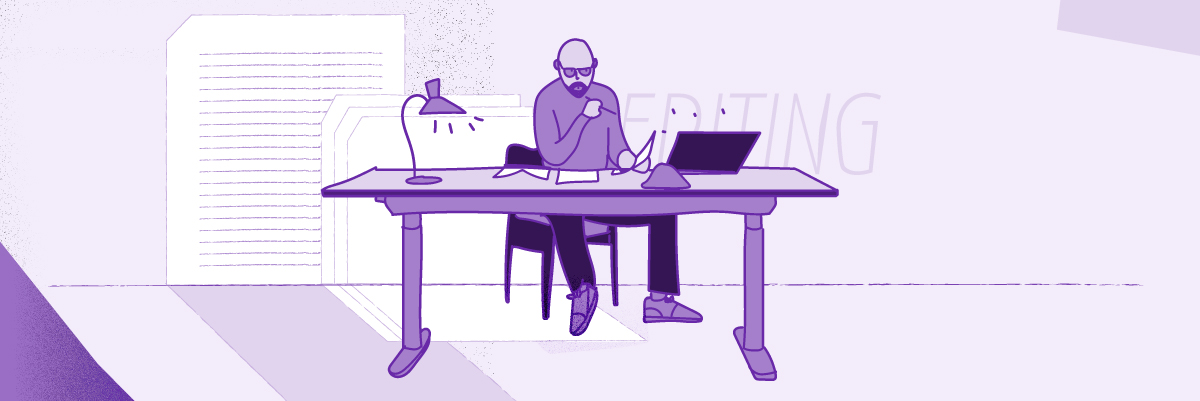Writing editing services – who really needs those? Many people who tackle writing casually, usually decide to prepare a certain text on their own, check it for possible grammar and spelling mistakes and then send it along. Even that seems easy these days with such useful online tools as Grammarly.
Yet, what happens when you write a specific complex text, one where a business is communicating to another business, or if such text is of legal nature? Should you just do a cursory check or do you go through a full process of editing and proofreading?
Of course, the answers to the above questions mean that you will have to engage in some form of writing editing services. So, what would be a quick definition of editing?
According to experts at Grammarly, “editing is the preparation of written material for publication. It’s a critical part of the writing process that shapes a rough draft into a polished final piece.“
“Editing serves multiple purposes: to fix mistakes, clarify the message, cut down (or build up) text to meet a specified word count, change the writing’s tone, make it fit particular constraints, and hone language for an intended audience” (above).
The definition may be brief and sound clear enough, but the whole editing process has a number of steps that have their own specifics. While these processes may overlap, they are actually separate from each other.
What is the difference between revising and editing?
There are three distinct processes within editing of writing, or writing editing services. All of them take place when you complete writing a certain text. Of course, it could be a brief email, or an extensive research thesis or a novel.
The first step in the process is revision. According to the University of Minnesota, “when you revise, you take a second look at your ideas. You might add, cut, move, or change information in order to make your ideas clearer, more accurate, more interesting, or more convincing.”
In most cases, revision is something that falls upon writers of the text themselves. Yet, it is also common that with quite a number of texts, revision is also done by an editor. This is particularly the case when the text in question is complex and/or of a longer nature.
In those situations, such an editor works in close cooperation with the author and has in front of her/him a detailed brief what is the goal and what are the main ideas of the text.
During editing itself, the author or the editor takes a second look at how the author expressed her/his ideas. The editor’s task here is to add or change words. She/he also has to fix any problems in grammar, punctuation, and sentence structure.
Essentially, the goal of editing is to improve the writing style. “When a piece of writing has unity, all the ideas in each paragraph and in the entire essay clearly belong and are arranged in an order that makes logical sense. When the writing has coherence, the ideas flow smoothly. The wording clearly indicates how one idea leads to another within a paragraph and from paragraph to paragraph” (UMN, above).
Proofreading and types of editing
There is one last step in the complete editing process, and it is proofreading. Quite a number of people think that editing and proofreading are one and the same. Still, while editing and proofreading can overlap too, they are also distinctive processes.
According to a standard definition, proofreading is a surface-level check. It is the final check performed on a document. A proofreader will look for misspellings, incorrect/missed punctuation, inconsistencies (textual and numerical), and others.
Note the difference here between proofreading and editing, which, as mentioned above, corrects issues at the core of writing like sentence construction and language clarity. That is why in most cases the editing and proofreading are done by different persons.
As far as editing itself is concerned, according to Grammarly (above), there are seven distinct types of editing. Still, in most cases, it is one editor that covers all these types/steps:
- Developmental editing – This is the earliest stage in the process and actually concedes with revising. “It examines “big picture” components like the piece’s overall vision and message, and whether they’re clear throughout. With developmental editing, the goal is to assess how to present the writing in a clear way that effectively conveys its goals. If you’re developmentally editing a fiction work, part of this stage also involves inspecting if certain genre elements align with what readers will expect from the story.
- Structural editing – This is also known as evaluation editing. “With structural editing, the editor specifically examines how the piece’s structure works to communicate its message, rather than whether it communicates the message effectively overall.”

More on types of editing
- Content editing – This type of editing deals with the effectiveness of the message expressed within a certain text. “It questions if and how a piece aligns to others like it—specifically, at a magazine, brand blog, or similar publications.”
Here, the editor deals with the flow and section-by-section construction of the piece and aims to improve consistency, pacing, appropriateness for the intended audience, and how individual sections present the writer’s thoughts.
“ A content editor will also check whether a piece aligns with a brand’s standards and brand voice and tone in order to speak to a specific audience. Sometimes this also entails having SEO in mind.” - Line editing – This is quite an appropriate name for this part of the process. Here, the editor reads the text line by line and optimizes individual words, phrases, and sentences to deliver the strongest impact. “Line editing focuses on style and how each individual element contributes to the overall purpose or effect of a piece.”
- Copy editing – This is the more technical part of editing. Here, the editor audits spelling, grammar, style, and punctuation. The goal is to “enhance a text’s readability, which can involve finessing transitions, honing language to fit a specific style and audience, adhering to style conventions, and ensuring logical flow and continuity.”
- Fact-checking – “As the name implies, fact-checking is the process of checking the facts presented in a piece of writing to ensure they’re accurate. This can even include ensuring slang is appropriate for a specific era in a historical fiction novel or testing that math or figures are correct in a financial report.”
- Proofreading – as defined above, this is the last step in the editing process. Very often, proofreading is done at the same time as fact-checking.
Editing writing
Every editing process has one and the same goal: to make the writing as strong as it can be and to present the intended ideas in the best possible manner.
On the other hand, the editing process itself can depend on the type, style and complexity of each individual text/document. Simply put some texts need more editing as well as different types of editing.
Each and every editor has to be fully aware of the writer’s goals. That is the only way that she/he can tackle her/his job properly. In this manner, editors will know exactly what changes they need to suggest to the author.
On the technical side of the process, each and every editor has to be familiar with the standard proofreader’s marks. This is particularly the case if they are editing hard copies, i.e., printed text. “These marks make it easy for the writer and any other editors with whom you’re collaborating to understand the changes you’re suggesting.”
What editing process an editor has to apply to a certain text certainly depends on its content. Editing a novel will practically involve all of the above types of editing. On the other hand, editing a press release will include content editing, copy editing as well as fact-checking and proofreading.
The fact that an editor has to be fully aware of the writer’s goals indicates the fact that the editor and writer have to be in full and constant communication. Each will probably have quite a number of questions about the ideas in the text, as well as about the possible changes.
Writing editing services – the ultimate goal of editing
The key thing here is that both the writer and the editor are working towards the same goal. They want the potential reader to fully grasp and understand the text. The reader has always to be on the mind of both the writer and the editor, they work towards the same goal.
They have to consider things like the reader’s “reading level, their familiarity with the subject, and the reason why they’re reading the piece.”
“A great way to assess whether a piece of writing is appropriate for its intended reader is to determine the piece’s readability—the quality of being legible and understandable by a target audience. “
Of course, these two roles can be rolled into one person who is both the writer and the editor. Still, ultimately, it comes down to the question of the length and the complexity of the text, as well as one very important one. That is subjectivity.
Very often, it is hard for the writers to be fully subjective about their writing and how it conveys the key ideas. Of course, each writer will use a grammar and spell checker. Yet it can be very hard to notice and be objective whether the text fully conveys the ideas if you are the author.
That is why in 99% of the cases it is essential to use some form of writing editing services. Those services could be just editing and/or proofreading, or they can include revision i.e. developmental editing.
In all of the above situations, BunnyStudio can be both of service and help. We offer a wide range of both writing editing and proofreading services through our extensive list of carefully selected freelancers who can do these jobs for you.










